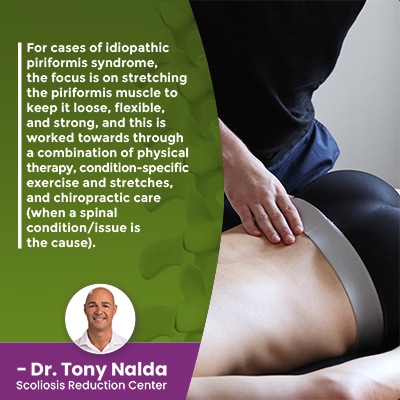The piriformis muscle is essential for lower body function and movement, including the pelvis, hips, and the legs. When the piriformis muscle spasms, it affects its surroundings, which includes nearby nerves, like the sciatic nerve. If the sciatic nerve is irritated, it can cause pain felt anywhere along its extensive pathway.
The piriformis muscle starts in the lower spine and connects to the upper femur of each thigh. If the piriformis muscle spasms and causes pain, this is known as piriformis syndrome. Piriformis muscle spasms can be painful as they irritate the nearby sciatic nerve.
When a muscle is strained and/or spasms, it can affect its surroundings, and this is why the close proximity of the piriformis muscle and the sciatic nerve is so often problematic.
What is the Piriformis Muscle?
As mentioned, the piriformis muscle starts in the lumbar spine (lower back), passes through the sciatic notch, and connects the vertebrae at the base of the spine to the upper part of the leg.
The sciatic notch is the opening in the pelvis through which the sciatic nerve extends into the leg; at this location, the piriformis muscle is adjacent to the sciatic nerve, and this close proximity can be problematic.
The piriformis muscle is essential in lower body function and movement; it externally rotates the thigh and upper leg muscles.
During hip extension and flexion, the muscle laterally rotates and abducts the femur, so is an essential part of limb mobility.
What is the Sciatic Nerve?
The sciatic nerve is the largest nerve in the body; its path is extensive, starting in the lumbar spine and extending down the hip, buttock, leg, and into the foot.
The sciatic nerve is a mixed nerve containing both motor and sensory fibers, which is why sciatic nerve irritation can cause strange sensations and mobility issues.
When the sciatic nerve is pinched, irritated, inflamed, compressed, and/or impinged, it can cause pain felt anywhere along the nerve’s extensive pathway.
In most cases, sciatic nerve pain is felt down the left side of the body, but it can also affect the right, and in rare cases, affects both.
In most cases, sciatica involves flare ups, during which time symptoms intensify, then abate for varying lengths of time.
Some cases of sciatic nerve pain resolve on their own in a number of weeks, while others persist, and if the underlying cause of the sciatic nerve compression isn’t determined or addressed, the issue is unlikely to resolve, and can get worse over time if the sciatic nerve becomes damaged.
Sciatica isn’t a condition itself, although many think it is, sciatica refers to the symptom of pain felt along the nerve’s pathway, but doesn’t indicate its cause.
So sciatic nerve pain is a symptom of sciatic nerve compression, and there are different causes for the sciatic nerve becoming irritated, one of which is the piriformis muscle spasming and compressing the sciatic nerve.
Symptoms of Piriformis Syndrome

If the piriformis muscle is strained, sore, and spasms, it can compress the nearby sciatic nerve where it exits the pelvis, and this can cause varying levels of pain that can range from mild and intermittent to chronic and debilitating.
Or if there is simply less room between the muscle and nerve for a number of reasons, this can also be problematic.
If the piriformis muscle compresses the sciatic nerve, it can cause pain that radiates from the lower back and/or buttock, into the leg, calf, and foot.
While the reason remains unclear, piriformis syndrome is more common in females than males, and additional symptoms can include:
- Sharp radiating pain throughout the lower body
- Hip pain during movement
- Reduced range of motion in the hip joint and lower body in general
- Difficulties with putting weight on the buttock (sitting can be a challenge during a flare up)
- Pain that tends to increase while sitting for long periods
- Piriformis muscle spasms
Condition severity and causation always plays a role in the type of symptoms a condition causes, so let’s talk about some common causes of piriformis syndrome.
Piriformis Syndrome Causes
Once a condition’s underlying cause is determined, treatment plans can be crafted accordingly.
If a condition’s underlying cause isn’t addressed with treatment, this means only its symptoms are being addressed, but not their actual cause: the condition itself.
In many cases of piriformis syndrome, conditions are idiopathic, meaning the cause is unknown, but some recognized causes can include:
- Injury/trauma
- A misaligned spine (caused by spinal conditions like scoliosis)
- An typical development/location of the sciatica nerve and/or piriformis muscle
- Leg length discrepancy (LLD)
- Sitting for long periods of time (particularly if carrying objects like wallets in the back pocket adding uneven pressure)
- Hip surgery
- Strain for overuse or excessive exercise
- Foot conditions
The best way to minimize the potential effects of piriformis syndrome is to treat it proactively.
Piriformis Syndrome Treatment Options

The focus of a conservative treatment approach would be first determining the condition’s underlying cause and crafting and customizing a treatment plan accordingly.
While pain medications, muscle relaxants, and anti-inflammatory drugs are an option, this is more about short-term pain relief, and a conservative treatment approach focuses on how best to deliver sustainable long-term pain relief, and this is through addressing the underlying cause: piriformis muscle health and its proximity to the sciatic nerve.
If an underlying condition is the cause, such as scoliosis or leg length discrepancy, those conditions have to be the focus of treatment as they are causing the piriformis muscle/sciatic nerve irritation.
Conditions that disrupt the body’s symmetry can affect the entire body, including its muscles and nerves, so if an unnatural spinal curve in the lower spine, or differing leg lengths, is causing compression and postural changes that affect the piriformis muscle, the unnatural curve/LLD has to be corrected; as this happens, the uneven forces affecting the piriformis muscle are addressed.
If an injury is the cause, the injury has to be treated, and this can involve rest, physical therapy, and chiropractic care.
For cases of idiopathic piriformis syndrome, the focus is on stretching the piriformis muscle to keep it loose, flexible, and strong, and this is worked towards through a combination of physical therapy, condition-specific exercise and stretches, and chiropractic care (when a spinal condition/issue is the cause).
Changes to gait can help, as can working to improve sacroiliac joint mobility, and stretching to relieve tight piriformis and surrounding hip muscles.
Physical therapy and exercise can help with strengthening the hip abductors, and heat therapy can help with inflammation and pain.
Conclusion
Piriformis syndrome is linked to the sciatic nerve as its close location within the pelvic bone can be problematic.
If the piriformis muscle that starts in the lower back and extends into the upper thighs becomes stiff, tight, sore, and strained, lower body mobility can be affected, as can nearby nerves like the sciatic nerve.
If a piriformis muscle spasms, it can introduce uneven pressure (compression) to the nearby sciatic nerve, and if the sciatic nerve becomes irritated, it can cause pain felt anywhere along the sciatic nerve’s extensive pathway throughout the lower body.
The body is designed to be symmetrical and have an established center of gravity, but there are a number of conditions/issues that disrupt the body’s overall symmetry, and these uneven forces can also affect muscles and nerves.
If a condition like scoliosis that involves the development of an unnatural spinal curve, or leg length discrepancy where the legs are different lengths, causes postural changes that affect surrounding muscles/nerves, such as the piriformis muscle that facilitates lower limb movement, those conditions have to be addressed proactively.
If piriformis syndrome is idiopathic, with no known cause, it can be treated with a conservative treatment approach that combines the benefits of physical therapy and condition-specific exercise and stretches.
When the piriformis muscle is exposed to uneven pressure due to a misaligned spine, chiropractic care can include manual adjustments that realign the spine, and physical therapy, exercise, and stretching can help keep the piriformis muscle loose, flexible, and strong; healthy muscles facilitate the smooth gliding motion of nearby joints, including the hip joint.
Here at the Scoliosis Reduction Center®, I have experience treating a wide range of spinal conditions/issues, and when it comes to piriformis syndrome, I focus on first determining if there is an underlying structural issue causing an asymmetry that’s irritating the muscle, and then increasing its strength and flexibility through physical therapy, exercise and stretches.




